Maximilian Egon II, Prince of Fürstenberg
Maximilian Egon II, Prince of Fürstenberg (13 October 1863 – 11 August 1941) was a German landowner, investor, and the head of the House of Fürstenberg.
| Maximilian Egon II | |
|---|---|
| Prince of Fürstenberg | |
.png.webp) Photograph of Max Egon II, 1890s | |
| Prince of Fürstenberg | |
| Tenure | 1896–1918 |
| Predecessor | Charles Egon IV |
| Successor | Karl Egon V |
| Born | Maximilian Egon Christian Karl Aloys Emil Leo Richard Anton 13 October 1863 |
| Died | 11 August 1941 (aged 77) |
| Spouse | Countess Irma von Schönborn-Buchheim |
| Issue | Karl Egon V, Prince of Fürstenberg Princess Leotina Princess Anna Prince Maximilian Egon Prince Friedrich Eduard Marie-Louise-Auguste von Almey |
| House | Fürstenberg |
| Father | Prince Maximilian Egon of Fürstenberg |
| Mother | Countess Leontina von Khevenhüller-Metsch |
Early life
Born as Prince Maximilian Egon Christian Karl Aloys Emil Leo Richard Anton zu Fürstenberg, he was the son of Prince Maximilian Egon zu Fürstenberg, and his wife Countess Leontina von Khevenhüller-Metsch. He had a younger brother, born in 1867, named Prince Karl Emil Egon zu Fürstenberg.[1]
Life and career
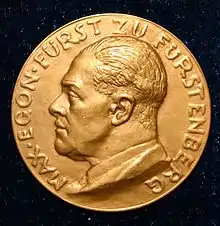
A close friend and adviser of Emperor Wilhelm II of Germany,[2] Max of Fürstenberg inherited territorial titles in Prussia, Austria, Hungary, Württemberg and Baden, and by virtue of them had a seat in the House of Lords in each of the five states.[3] Until the First World War, he was vice-president of the Prussian House of Lords.[4]
His principal residence was at Donaueschingen, near the source of the Danube, where he owned a castle and great deer forests.[5] Emperor Wilhelm II frequently visited him there, and Max invariably accompanied the Emperor on his hunting expeditions and Norwegian trips. As well as his vast ancestral forests, he also owned coal mines, hotels and breweries.[6]
Although he was a member of the high Roman Catholic Uradel who had long stood aloof from party politics, after meeting Adolf Hitler and Ernst Roehm in November 1933, Max became enthusiastic about Hitler's leadership, commenting that "It was wonderful, to be able to meet such a great man".[2]
The same year, 1933, he joined the Nazi Party and the SA. In 1938, he was appointed to the rank of Standartenführer.[7]
Personal life
By his marriage to Countess Irma von Schönborn-Buchheim, he had three sons and two daughters:[5]
- Karl Egon V zu Fürstenberg (1891–1973)
- Leontina zu Fürstenberg (1892–1979)
- Anna zu Fürstenberg (1894–1928)
- Maximilian Egon zu Fürstenberg (1896–1959)
- Friedrich Eduard zu Fürstenberg (1898–1916)
He also had an illegitimate daughter, Marie-Louise-Auguste von Almey, by a liaison with Baroness Marguerite von Almey.
He died in 1941, during the Second World War, and was succeeded by his son, Karl Egon V (1891–1973).[7]
Gallery
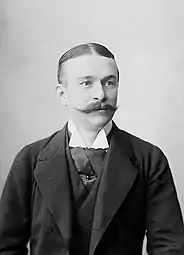 Photograph, 1897.
Photograph, 1897.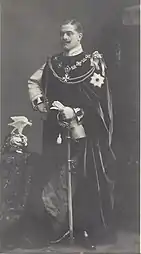 Photograph, c. 1905.
Photograph, c. 1905. Portrait, by Philip de László, 1899.
Portrait, by Philip de László, 1899. Portrait, by Philip de László, 1899.
Portrait, by Philip de László, 1899.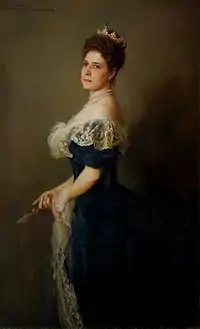 Portrait of his wife Irma, by Philip de László, 1899.
Portrait of his wife Irma, by Philip de László, 1899. Photograph and signature, 1913.
Photograph and signature, 1913.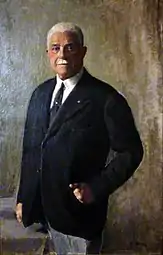 Portrait from the Market Hall of Freiburg.
Portrait from the Market Hall of Freiburg.
Citations
- The Encyclopædia Britannica: A Dictionary of Arts, Sciences, Literature and General Information. Cambridge University Press. 1910. p. 366. Retrieved 6 March 2020.
- Eckart Conze, Monika Wienfort, eds., Adel und Moderne: Deutschland im europäischen Vergleich im 19. und 20. Jahrhundert, p. 136: "Es war herrlich, diesem einzig grossen Mann gegenueberstehen zu duerfen."
- Otte, T. G. (2014). July Crisis: The World's Descent into War, Summer 1914. Cambridge University Press. p. 49. ISBN 978-1-139-99332-6. Retrieved 6 March 2020.
- Kohut, Thomas August (1991). Wilhelm II and the Germans: A Study in Leadership. Oxford University Press. p. 39. ISBN 978-0-19-506172-7. Retrieved 6 March 2020.
- Röhl, John C. G. (2014). Kaiser Wilhelm II: A Concise Life. Cambridge University Press. pp. 28, 109, 111, 114, 121, 123, 136, 163. ISBN 978-1-107-07225-1. Retrieved 6 March 2020.
- Rines 1920.
- John Kennedy, John E. James, eds., Almanach de Gotha 2004, Vol. 1, p. 508
General references
- This article incorporates text from a publication now in the public domain: Rines, George Edwin, ed. (1920). . Encyclopedia Americana.
External links
 Media related to Max Egon II. zu Fürstenberg at Wikimedia Commons
Media related to Max Egon II. zu Fürstenberg at Wikimedia Commons